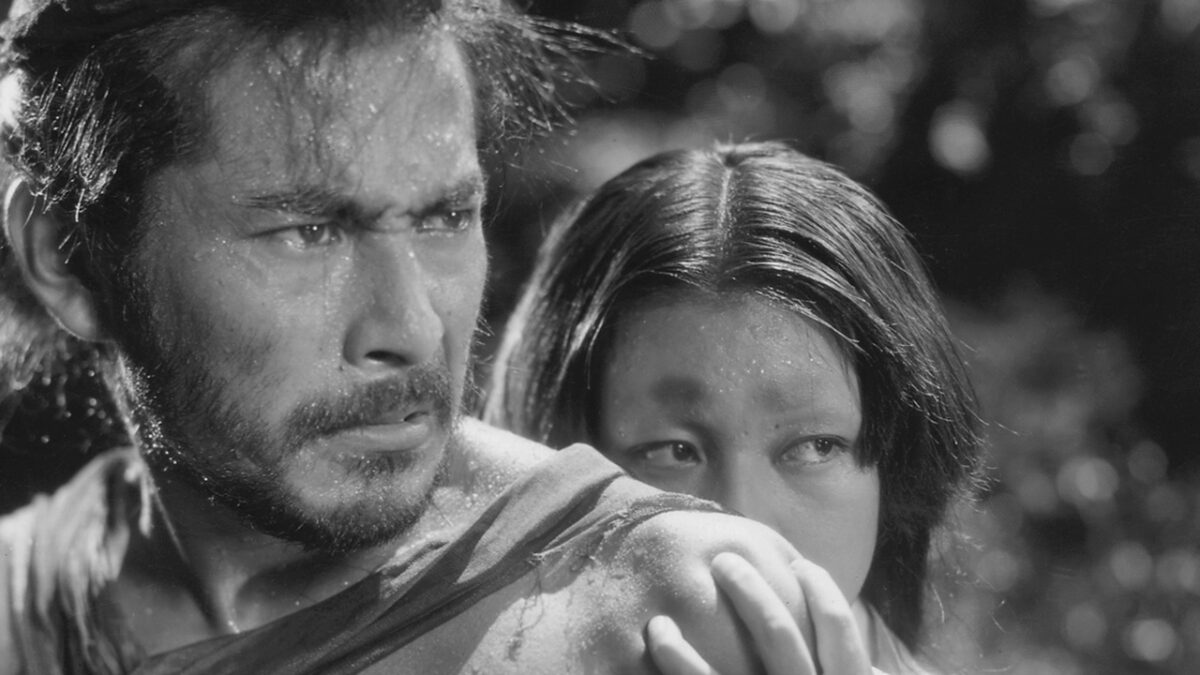Welcome to our Colossus Movie Guide for Rashomon. This guide contains everything you need to understand the film. Dive into our detailed library of content, covering key aspects of the movie. We encourage your comments to help us create the best possible guide. Thank you!
What is Rashomon about?
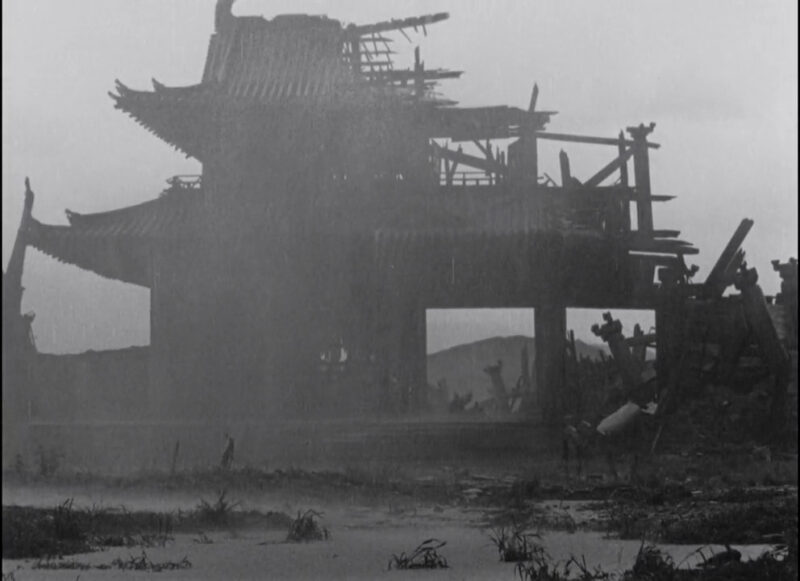
At its core, Rashomon is an exploration of truth and perspective, delving into the subjective nature of reality. The film uses four differing accounts of the same event to expose the self-serving nature of human memory and perception. This narrative structure, known as the “Rashomon effect,” plays with our understanding of what truth is, suggesting that it may be more complex and elusive than we often assume.
The film also delves into the darker side of human nature. Each character’s account reveals their own selfishness, dishonesty, or fear, painting a rather grim picture of human morality. The characters seem more interested in protecting their self-image than finding the truth, which emphasizes the power of ego in shaping our interpretation of reality. Despite the bleak outlook, Rashomon ends with a note of redemption, suggesting that even in the face of life’s grim realities, there remains the potential for human compassion and hope.
Movie Guide table of contents
Cast
- Takashi Shimura – Kikori, The Woodcutter
- Minoru Chiaki – Tabi Hōshi, The Priest
- Kichijiro Ueda – The Commoner
- Toshiro Mifune – Tajōmaru, The Bandit
- Machiko Kyō – The Wife
- Masayuki Mori – The Samurai
- Noriko Honma – Miko, The Medium
- Daisuke Katō – Houben, The Policeman
- Shinobu Hashimoto – Writer
- Akira Kurosawa – Writer and director
The ending of Rashomon explained
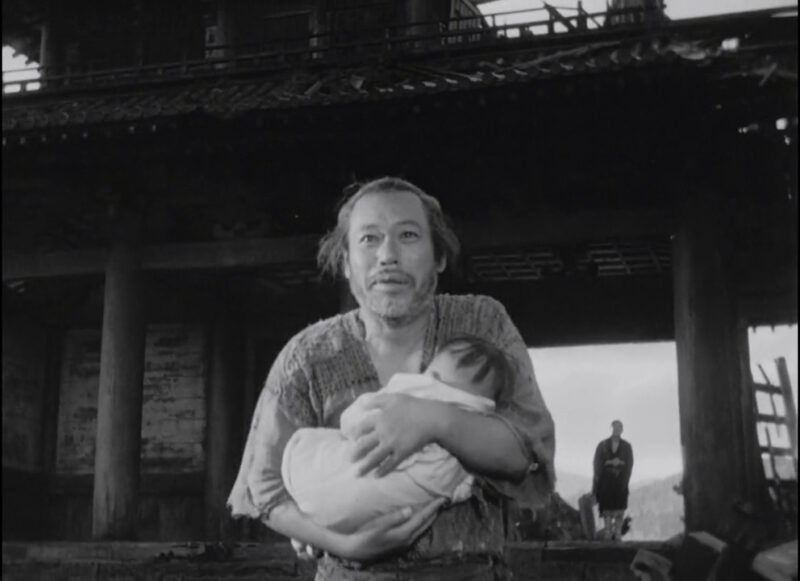
A recap of the ending
The narrative at the heart of Rashomon reaches a poignant crescendo when the Woodcutter, the Priest, and the Commoner are drawn from their discourse by the sound of an infant’s cry. Upon investigating, they discover an infant, forsaken and alone, nestled within a basket, its only possessions a kimono and a guardian amulet. Succumbing to temptation, the Commoner seizes both the kimono and the amulet.
Rebuking the Commoner for his heartless theft from a helpless child, the Woodcutter attempts to intervene. However, the Commoner is not so easily swayed, standing his ground and retaliating with an accusation. He surmises that the Woodcutter’s silence during the court proceedings stems from his guilt—he had made off with the dagger, a valuable piece of evidence. The Commoner, disillusioned with humanity, leaves the scene, maintaining his conviction that every individual is primarily driven by self-interest.
During this conflict, the Priest has been trying to comfort the distraught infant. Once the Commoner makes his exit, the Woodcutter steps forward to take the baby into his care. The Priest, shaken by the day’s events and now doubting humanity’s goodness, reacts in alarm. The Woodcutter then divulges his intention to adopt the child, already being a father to six of his own. This new piece of information paints the Woodcutter’s narrative in a different light and manages to restore the Priest’s dwindling faith in humanity.
As the Woodcutter gets ready to leave, cradling the baby tenderly, the sky clears, and the rain makes way for sunlight.
The innocence of a child
The appearance of the baby in Rashomon‘s conclusion serves as a profound embodiment of innocence, casting a poignant light on the other characters’ actions and beliefs. Amidst the maelstrom of self-interest, deceit, and moral ambiguity, this innocent life introduces an element of purity and hope. It’s an emblem of the innate goodness that lies beneath the complex tapestry of human nature.
The baby’s innocence starkly contrasts with the other characters, accentuating their flaws and moral complexities. The Commoner, the Priest, and the Woodcutter each react differently to the abandoned child, and these reactions reveal their core principles and convictions. The Commoner, who sees the world through a survivalist lens, views the child’s possessions as objects for his taking, reinforcing his view that the world is driven by self-interest. The Priest, on the other hand, is overwhelmed by the injustices he has witnessed and is initially resistant to the Woodcutter’s attempts to care for the baby.
The Woodcutter’s decision to adopt the baby, however, introduces a glimmer of hope and optimism in Rashomon. Despite his previous actions and the accusations hurled at him, his choice to care for the abandoned child highlights his capability for empathy and altruism. This single act of kindness challenges the film’s predominantly pessimistic perspective, reminding us that human beings are capable of selflessness and compassion.
In essence, the baby’s innocence acts as a mirror, reflecting the characters’ inherent virtues and vices. It unveils the cynical worldviews held by some, the shaken faith of others, and the capacity for empathy and generosity that can persist in spite of societal pressures and personal flaws. The presence of the baby, in its vulnerability and innocence, invites an examination of our shared humanity, nudging the audience to consider the inherent goodness that exists alongside our flaws. It’s a poignant reminder that even in a world often marred by self-interest and deceit, there is room for hope, compassion, and redemption.
The dagger’s important symbolic presence
The dagger serves as a critical motif throughout Rashomon, embodying various elements of truth, power, and deception, and evolving in meaning with each testimony. It’s an item that’s both concrete and symbolic, shifting its connotation according to the narratives spun by the characters.
In the first three testimonies—by the Bandit, the Wife, and through the Medium, the Samurai—the dagger is presented as a weapon, an instrument of death. Its interpretation varies in each story, reflecting the shifting power dynamics and moral perspectives of the characters. For the Bandit, the dagger represents conquest and power, while for the Wife, it embodies fear, victimhood, and eventually a weapon of self-defense. In the Samurai’s version, it becomes an instrument of his own death, underscoring his perceived loss of honor.
However, with the Woodcutter’s testimony, the dagger’s significance changes. It’s no longer an instrument of death but becomes an object of value, a prize coveted by the characters. This shift signifies the Woodcutter’s detached perspective, viewing the events not as an emotional drama, but as an outsider interested in the material worth of the dagger.
The Commoner’s accusation that the Woodcutter stole the dagger throws a new light on this motif. The dagger, in this context, symbolizes deceit and the human propensity to distort the truth for personal gain. Just as the characters manipulate their narratives for self-preservation, the Woodcutter, accused of stealing the dagger, presumably distorts his testimony to maintain his self-image.
By remaining silent during the initial three testimonies, the Woodcutter protects his self-image, reflecting the societal pressure to appear honorable, even if it involves distorting or suppressing the truth. His desire to protect his reputation correlates with the testimonies shared during the trial where each character manipulated the truth to cast themselves in a favorable light. The Woodcutter’s silence and the Commoner’s accusation are both indicative of the subjectivity of truth—the idea that truth can be malleable and altered according to one’s perspective or self-interest.
The Commoner’s accusation invites the audience to reconsider all the narratives shared earlier in the film, thereby enhancing the film’s theme of subjective truth. Just as the Bandit, the Wife, and the Samurai all tell different versions of the event, the Commoner presents yet another perspective—that the Woodcutter, who initially seemed an impartial observer, has his own version of truth, obscured by his own motivations.
The Woodcutter’s redemption
The Woodcutter’s redemption at the end of Rashomon stands as a powerful counterpoint to the film’s pervasive atmosphere of deceit and selfishness. His decision to adopt the child not only reveals an unexpected capacity for altruism but also introduces a sense of hope into a narrative steeped in cynicism, ultimately presenting a complex view of human nature.
Throughout the film, the characters have manipulated the truth, acting primarily out of self-interest. However, when confronted with the baby’s innocence, the Woodcutter makes a selfless choice. His decision to adopt the child serves as a redeeming act that challenges the film’s bleak portrayal of human nature. It introduces the possibility that even in a world shadowed by deceit, compassion and altruism can thrive. This act of kindness, stark in contrast to his earlier silence on the theft of the dagger, highlights the complexity of human nature. It suggests that individuals are capable of both selfishness and kindness, deceit and honesty, thereby presenting a more nuanced view of humanity.
Kurosawa leaves the audience with an optimistic note by showcasing the Woodcutter’s redemption. It suggests the possibility of change and the potential for goodness in even seemingly self-serving individuals. The Woodcutter’s act of compassion challenges the narrative of relentless self-interest, suggesting that individuals are not bound by their past actions and can choose to act selflessly.
The Rashomon city gate, a recurrent motif throughout the film, takes on a new meaning during this moment of redemption. It has previously been portrayed as a symbol of decay and despair, reflecting the moral ambiguity of the characters’ stories. However, as the Woodcutter leaves through the gate with the baby, it becomes a passageway to a new beginning, a symbol of hope and redemption. The gate, once a symbol of societal decay, now frames the Woodcutter’s departure into a future that promises a chance at renewal and the cultivation of virtue.
The emergence of sunlight
The final scene, where the rain subsides and the clouds give way to sunlight, carries deep symbolic significance. It coincides with the Woodcutter’s act of kindness, suggesting a renewal of faith in human nature. The sunlight, breaking through the gloom, signifies hope and redemption, indicating that despite humanity’s propensity for self-interest and deception, there is also a capacity for altruism and goodness.
Sunlight serves as a recurring motif in Rashomon, playing a vital role in the film’s exploration of truth and human nature. Its symbolism evolves as the narrative unfolds, reflecting changes in mood, perceptions, and revelations.
In the trial scenes, sunlight is often obscured, aligning with the nature of the testimonies being presented—clouded, altered, and difficult to discern. Much like the elusive truth the characters grapple with, the sunlight during the trial is often hidden or diffused, suggesting the obscured and subjective nature of truth.
During the stories, the sunlight penetrates the forest in sharp, angular beams, creating a stark, dramatic ambiance. It represents the blinding self-interest and the subjective versions of truth each character presents. The inconsistent lighting emphasizes the distortions and manipulations of the narrative, reflecting the conflict between appearance and reality. It becomes an element of visual storytelling that communicates the tensions and contradictions in the characters’ accounts.
At the end of the movie, the emergence of sunlight after a torrential downpour represents a shift in the narrative’s atmosphere and the characters’ state of mind. It correlates with the Woodcutter’s decision to adopt the baby, signifying a moment of redemption, hope, and newfound clarity. In this context, sunlight transforms from a symbol of distorted truth and selfishness to a symbol of optimism, change, and a possible return to moral integrity.
The sunlight, coming after the storm, also suggests the cyclical nature of life—the alternation of dark and light periods, despair and hope, lies and truth. The radiant sunlight that illuminates the Rashomon city gate as the Woodcutter leaves with the baby serves to reinforce the film’s closing note of optimism. It underlines the possibility of redemption and the potential for kindness, even amidst a world steeped in deceit and self-interest.
The themes and meaning of Rashomon
The subjectivity of truth
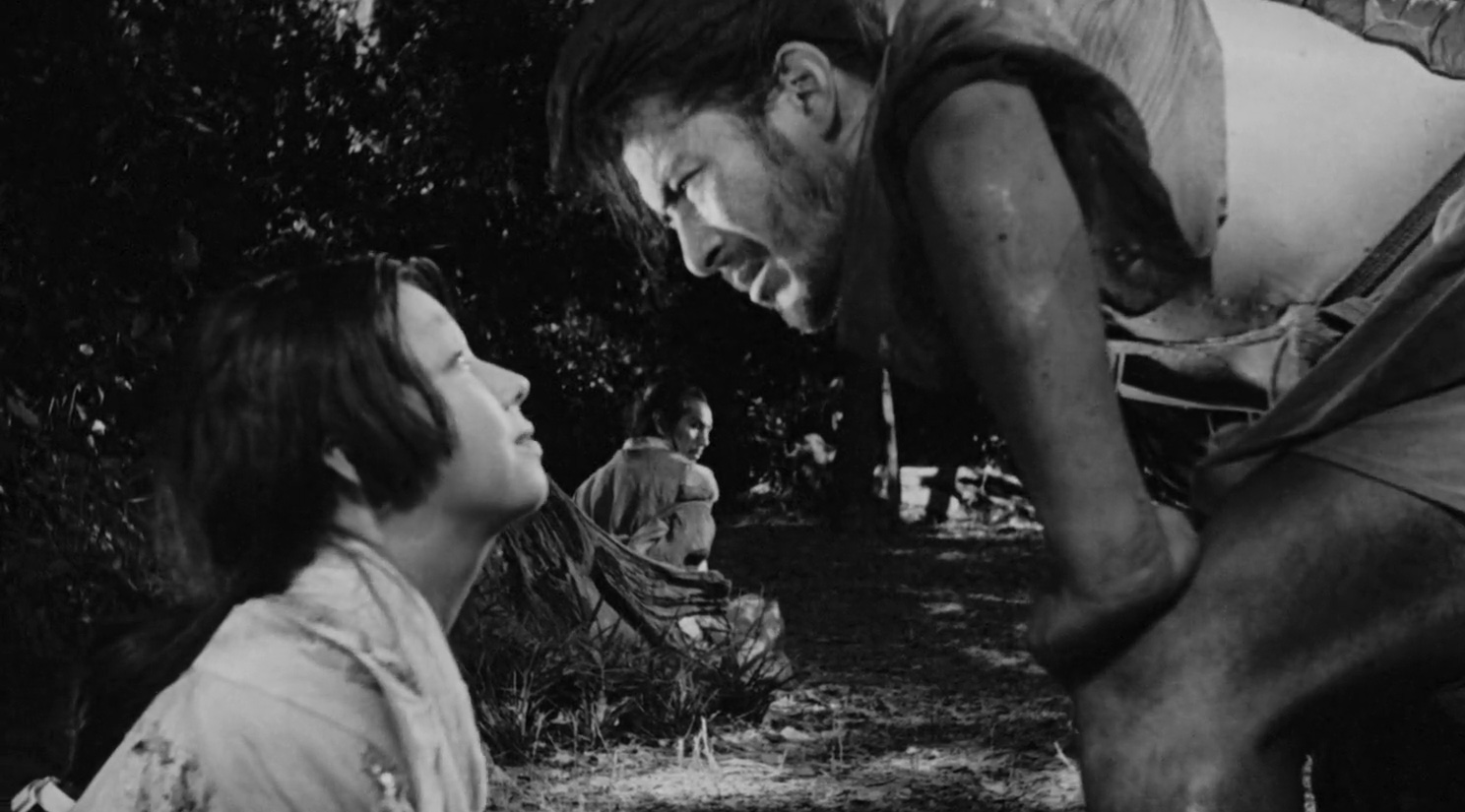
By presenting truth as something personal, elastic, and unreliable, Rashomon effectively dismantles the concept of an objective, universal truth. The film invites the viewer to question their assumptions about truth and to recognize that truth often lies somewhere in the complex intersection of different perspectives.
Let’s review a few ways this theme functions in the film.
Using “truth” to protect ego
In Rashomon, the theme of subjective truth is deeply intertwined with the pressure to protect our self-images. The Bandit, the Wife, and the Samurai each tell a story that not only contradicts the others but also paints them in a light that aligns with their desired self-perceptions. This self-serving distortion of reality not only reveals an inherent human tendency to self-preserve, but it also reflects broader societal dynamics and expectations.
For the Bandit, his account paints him as a heroic figure, challenging the Samurai to a fair duel and winning the heart of the woman. The Wife’s narrative, on the other hand, portrays her as a pitiful and tormented figure, a victim of both the Bandit’s aggression and her husband’s scorn. The Samurai, telling his tale through the Medium, depicts himself as a tragic figure, dishonored and betrayed. These narratives, while in stark contrast to each other, all serve to uphold each character’s self-image.
The motif of ego is crucial in portraying the theme of subjective truth. Each character’s ego shapes their version of the events, warping the truth to preserve their self-image and justify their actions. The Bandit boasts of a noble duel, the Wife emphasizes her victimhood, and the Samurai portrays himself as a tragic hero – each narrative inflated by ego and self-interest. This reflection of ego’s influence on the interpretation and narration of events suggests that subjective truth is often a product of self-serving biases.
These self-serving narratives speak to a deep-seated human need for self-affirmation and a desire to be perceived favorably by others. This need can be traced back to our evolutionary roots, where being part of a group and being seen positively by its members was crucial for survival. Consequently, we are often compelled to present ourselves in ways that conform to societal norms and expectations, even if it means distorting the truth.
This tendency reflects the pervasive influence of societal expectations and pressures on our behavior and self-perception. Society, with its norms and standards, shapes how we see ourselves and how we want to be seen by others. Consequently, it can exert considerable pressure on individuals to portray themselves in certain ways, often prioritizing socially desirable traits and characteristics over authenticity.
Truth’s effect on social identity
The subjectivity of truth, as portrayed in Rashomon, speaks to broader societal dynamics that are as relevant today as they were when the film was first released. As the film illustrates, our understanding of truth is often shaped by our individual perceptions, experiences, and biases. These subjective truths end up informing not only our individual identities but also the collective identity of society.
The Rashomon city gate, dilapidated and abandoned, stands as a potent motif of societal decay and moral ambiguity, providing a core for the setting of the film and framing the exploration of subjective truth. It is under this gate that the woodcutter and the priest recount the contradictory testimonies, and where we, as the audience, grapple with the perplexing variations of truth. The gate serves as a metaphorical threshold between the “real” world and the world of subjective narratives, indicating the difficulty of discerning objective truth in a world mired in decay and deception.
Subjective truths can lead to division when different groups or individuals hold onto their version of events as the only valid interpretation. Such divisions can be seen in various societal contexts, from political discourse and cultural conflicts to historical interpretations and scientific debates. Different communities, political groups, or even nations may have conflicting narratives about the same event, each shaped by their unique experiences, beliefs, and values. These conflicting narratives can lead to misunderstanding, animosity, and even violence, further fragmenting society.
In our increasingly connected and information-saturated world, the subjectivity of truth has become even more pronounced. The proliferation of digital platforms and social media has given rise to “echo chambers,” where individuals or groups reinforce their own beliefs and perspectives, often at the exclusion of differing views. This has amplified the division caused by subjective truths, making it more challenging to reach a shared understanding or consensus.
However, acknowledging the subjectivity of truth can also have positive implications. Recognizing that our truths are shaped by our individual experiences and biases can foster empathy, open-mindedness, and a willingness to understand different perspectives. It can challenge us to critically examine our beliefs and assumptions, to seek out diverse viewpoints, and to engage in open, constructive dialogue. This awareness can be a stepping stone towards bridging societal divisions and fostering a more inclusive, empathetic society.
Rashomon leaves us with no clear, objective truth, and perhaps, therein lies the film’s enduring relevance. It forces us to confront the uncomfortable reality of subjective truth and its implications for individual and societal identity. It challenges us to grapple with the complexities of truth, perception, and reality, and in doing so, it offers a profound commentary on the human condition and the society we inhabit.
The role of judgment in truth
In Rashomon, the motif of judgment features prominently and plays a critical role in exploring the theme of subjective truth. It is through the lens of judgment that the characters’ differing accounts of the same event are presented and scrutinized, underscoring the complex relationship between truth, perception, and society.
The judges in the film represent societal norms and values. They stand as symbols of authority, arbiters of truth and morality. However, their judgment is colored by their own perceptions and biases, reflecting the subjectivity of truth. They are not passive observers but active participants in shaping the narrative. Their reactions and interpretations of the testimonies influence the audience’s understanding of the events, further blurring the lines between truth and falsehood.
This subjective judgment significantly impacts the characters being judged. The Bandit, the Wife, and the Samurai are compelled to present versions of the event that not only align with their self-image but also seek to manipulate the judges’ perceptions. Their narratives are shaped by the fear of societal judgment and the desire to appear favorably in the eyes of the judges. This manipulation of truth reveals a deep-seated fear of judgment and a desperate need to conform to social expectations.
From a broader perspective, the dynamic between the judges and the characters being judged paints a complex picture of society and its influence on the perception of truth. It suggests that truth is not merely a matter of objective fact but is intertwined with norms, biases, and power dynamics. It reflects a society where truth is not absolute but negotiable, subject to interpretation and manipulation.
The inability of the judges to arrive at an objective truth highlights the inherent limitations of human judgment. It reflects the complexities and ambiguities of human perception, suggesting that the quest for absolute truth may be a futile endeavor. It also points to the potential pitfalls of a society that overly relies on judgment and conformity, suppressing individual perspectives and diversity.
The complexity of human nature
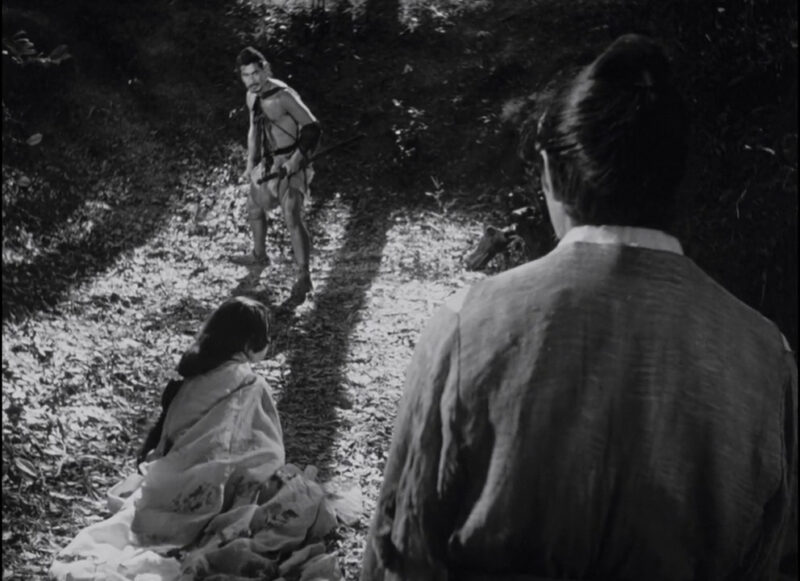
The exploration of human nature is a prominent theme in Rashomon. The film delves into the darker side of humanity, illustrating how self-preservation, ego, and fear can lead individuals to distort reality and manipulate truth.
However, despite its bleak portrayal of human nature, the film also explores the theme of redemption and the possibility for goodness within people. This is particularly evident in the conclusion when the woodcutter, who has been revealed as less than trustworthy himself, decides to adopt the abandoned baby. This act of compassion provides a stark contrast to the earlier selfishness and dishonesty, suggesting that humans, despite their flaws, are capable of altruism and love.
Let’s review how Rashomon observes the dark and light sides of human nature throughout the film.
Those who protect self-interests
Rashomon offers a seemingly pessimistic view of human nature, illustrating how individuals often prioritize their self-interests, even when it means bending the truth. This aspect is evident through the testimonies of the Bandit, the Wife, and the Samurai, each manipulating their version of events to protect their reputation and identity. The film, in doing so, reveals a bleak societal reality where preserving self-image and serving self-interests often outweigh the pursuit of objective truth.
The individual testimonies exemplify how self-interest can influence our perception and narration of events. The Bandit portrays himself as a valiant warrior who bests the Samurai in a fair fight, appealing to his sense of pride and bravado. The Wife, on the other hand, casts herself as a victim of the circumstances, a woman wronged by both the Bandit and her husband. The Samurai’s testimony, relayed through the Medium, paints a picture of a noble man, heartbroken and betrayed by his wife, who chooses to end his life. Each character manipulates the narrative to serve their interests, to portray themselves in a favorable light—a stark commentary on the self-serving bias inherent in human nature.
In the societal context of the film, the characters are compelled to craft narratives that safeguard their positions. Their testimonies not only serve as their defense but also as a means to project an image acceptable to their societal norms. The Bandit’s tale underscores his masculinity and bravado, the Wife’s her innocence and victimhood, and the Samurai’s his honor. It implies a societal system that pressures its members to act out of self-interest, fostering an environment where truth becomes negotiable and perception manipulable.
The forest in Rashomon stands as a potent motif symbolizing this tangled web of self-interest and subjective truth. It is within the forest that the crime occurs and the truths diverge. The forest, dense and labyrinthine, mirrors the convoluted nature of human intent, perception, and narrative. The characters’ journey into the forest signifies their descent into deception, their pathways obscured by their self-interests, just as the forest paths are shrouded in darkness and shadows. It serves as a backdrop for the characters’ moral conflicts and their individual quests to uphold their self-image.
The forest’s chaotic, wild nature can be seen as a reflection of society’s pressures and its complex moral landscape. Just as the characters struggle to navigate the forest, they also grapple with societal expectations and norms. It underscores the harsh reality of survival, where preservation of self often comes at the expense of truth and morality.
Those who lie and steal
The commoner’s actions in Rashomon provide a vital lens through which the film explores the theme of human nature, offering a seemingly pessimistic view of humanity’s inherent tendencies. This character, who does not partake in the central events of the film but serves as an observer, reflects the societal norms and behaviors that shape and influence individual actions.
The commoner attempts to steal the amulet—a very important motif in Rashomon—from the abandoned baby near the end of the film. He justifies this by arguing that everyone lies and steals to survive, reflecting his view of the world as a place where self-interest and survival come before ethics and empathy. His action symbolizes a grim outlook on humanity, where people are driven by self-serving motives and the need to survive, even at the expense of others.
This view is deeply pessimistic, suggesting that when faced with challenging circumstances, individuals may resort to morally dubious actions. The commoner’s actions highlight the potential for selfishness inherent in human nature. It suggests that, given the right circumstances, anyone could disregard ethical considerations for personal gain.
His attempt to steal the amulet also draws attention to society’s role in shaping human behavior. His assertion that “everyone lies and steals to survive” indicates that he views these behaviors as not just acceptable but necessary within his societal context. This perspective suggests that society, or at least the society the commoner experiences, has normalized self-interest and survival over ethical behavior. In this way, the commoner represents those parts of society where self-preservation overshadows moral actions.
Those who protect
Despite its often grim exploration of truth and human nature, Rashomon embraces redemption as one of its central themes. After a narrative filled with deception, self-interest, and moral ambiguity, the film concludes on a hopeful note, suggesting that redemption is possible even in a world mired in moral decay.
The motif of redemption is encapsulated in the final scenes of the film, where the woodcutter, despite his earlier deceit, decides to take the abandoned baby under his care. This decision marks a turning point in his character arc and represents a glimmer of hope amidst the bleakness. His act of kindness signals a break from the self-interest that pervades the characters’ testimonies, demonstrating the potential for goodness within humanity.
The amulet that comes with the baby plays a significant role in this theme of redemption. As a religious artifact, it symbolizes faith and hope. It also serves as a token of the woodcutter’s commitment to the path of righteousness, a tangible emblem of his promise to protect the child. In accepting the amulet and the child, the woodcutter embarks on a path of moral redemption, suggesting that it’s never too late to turn towards goodness.
This theme of redemption is further emphasized by the contrast between the Rashomon gate and the forest. The city gate, dilapidated and desolate, symbolizes a society in moral decline. On the other hand, the forest, despite its chaos and disorientation, becomes a place of revelation and transformation. It’s in the forest that the central event unfolds, pushing the characters into moral turmoil. Yet, it’s also in this wilderness that redemption becomes possible, hinting at the idea of growth and transformation even in the most unlikely circumstances.
The theme of redemption offers a counterpoint to the film’s grim portrayal of human nature and the subjectivity of truth. It infuses the narrative with a sense of optimism, reminding the audience that, despite our flaws and fallibility, human beings possess the capacity for compassion and change. This complex interplay of moral decay and redemption makes Rashomon a deeply human film, one that prompts the audience to contemplate the complexities of human nature, truth, and morality.
Why is the movie called Rashomon?

The title of the film, Rashomon, presents a thematic undercurrent that greatly enriches its exploration of truth and human nature. The name itself derives from the gate under which most of the story unfolds: the Rashomon gate of Kyoto, a then dilapidated, city entrance overrun by thieves and beggars. This detail may seem trivial at first glance, but upon closer examination, it forms a crucial part of the film’s symbolic language.
Rashomon uses the gate as a symbol for the moral decay that pervades the world of the film. It once stood grand and majestic, an emblem of order and civilization, but has now crumbled and become a haven for society’s outcasts. Much like the gate, the characters in the film have their own moral decay, their truth corrupted and disintegrating, just as the gate has fallen into ruin. The gate, in all its dilapidated grandeur, is the physical manifestation of the moral ambiguity and the subjective nature of truth explored within the narrative.
In a broader context, the Rashomon gate is also a liminal space, a threshold that exists between two different realities. In traditional Japanese architecture, gates often serve as transitional areas that connect the profane to the sacred. Thus, it can be seen as a passageway between the earthly, mundane world and the higher realms of truth. In the film, the characters’ testimonies transition from the worldly reality at the courtyard to the spiritual reality under the gate. It’s here that they grapple with their own perceptions and truths. It’s also here where the viewers, just like the characters, oscillate between different versions of truth, drawn into the ambiguity that makes Rashomon so captivating.
Rashomon subtly employs the gate as a metaphor for the viewers’ own experience. As the film progresses, we, as the audience, pass through the Rashomon gate alongside the characters. We are taken on a journey of multifaceted truths, each one refracted through the lens of personal perspective and self-interest. Just as the gate is the boundary between outside and inside, so too is the title, Rashomon, our entry point into this world of subjective reality. The film asks us to enter this world, and by doing so, it compels us to question our own perception of truth.
The title of the film is more than a reference to a place. It also becomes an emblem for the movie’s entire philosophy. Much like the characters’ stories which warp the truth to align with their interests, the Rashomon gate is an object transformed, its physical decay reflecting the moral decay of the individuals who seek refuge underneath. It echoes the film’s overarching message: truth is not absolute but subjective, mutable, and deeply personal. Thus, the title Rashomon is not merely a label but a symbol that encapsulates the central themes and questions posed by the movie.
Important motifs in Rashomon
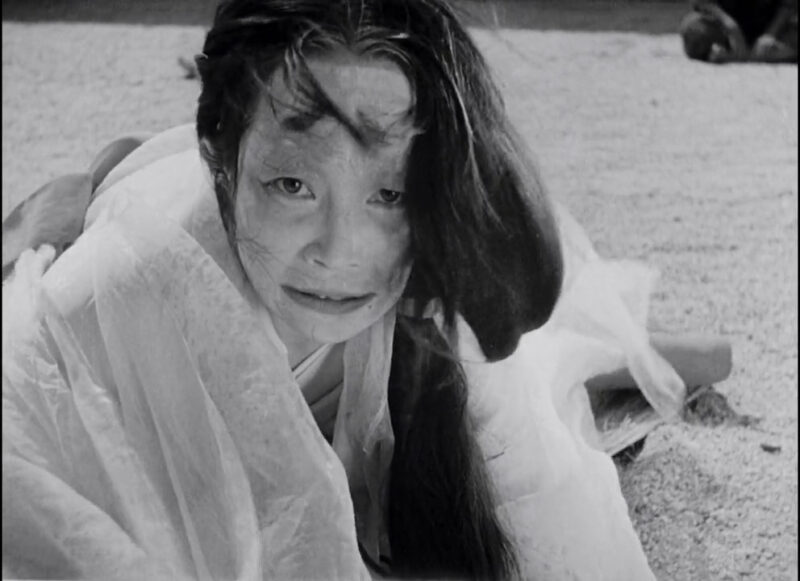
Truth and falsehood
There is a constant interplay between truth and falsehood in Rashomon. The four testimonies of the same event are all conflicting, each differing in crucial details. This dissonance raises the question: what is truth? Is it a universal reality, or is it a subjective interpretation based on individual perception? Each character in the film believes their version of the events to be the truth, and yet, each of these “truths” contradicts the others. This motif reflects the subjective and mutable nature of truth and reality, leaving the audience to grapple with their own definitions of truth and falsehood.
The Rashomon city gate
The Rashomon city gate becomes a physical representation of the moral decay and corruption that pervades the narrative. The gate’s disrepair parallels the disintegration of truth and morality within the characters’ conflicting testimonies. Additionally, the gate functions as a liminal space or transitionary threshold. It’s under this gate that the characters deliver their accounts, oscillating between their own perceived realities and the uncertain objective truth. The Rashomon city gate encapsulates the film’s exploration of the subjectivity of truth and the mutable nature of morality.
The amulet
The amulet serves as commentary on faith and redemption in Rashomon. It is found with the abandoned baby at the end of the film. This small artifact, an object of religious significance, marks a turn from the bleak examination of human nature to a moment of hope and redemption: the commoner attempts to steal the amulet from the baby, but the woodcutter stops him. When the woodcutter decides to take the baby and the amulet, the priest is overcome by the act of altruism on the other side of the ugly trial. It suggests an act of faith in humanity and a desire for moral redemption, even amidst a world of perceived moral decay.
The dagger
The dagger symbolizes betrayal, power, and control. Its presence and absence in different versions of the story reflect the shifting power dynamics and the manipulations of truth by the characters. For example, in the Samurai’s testimony, the dagger is used by his wife to free him, but in the Wife’s account, the dagger is the weapon she uses in a desperate act of self-defense. Its fluctuating role in the characters’ narratives underscores the film’s central theme of subjective truth.
Judgment
As the various testimonies are relayed, we see the characters passing judgment on one another based on their versions of the truth. Even the woodcutter and the priest, who serve as listeners to the narratives, engage in judgment, reflecting their perspectives and biases. The film employs this motif to pose questions about the nature and fairness of judgment, especially when truth is subjective and reality is mutable.
The forest
The forest in Rashomon serves as a potent motif, embodying both the chaos and complexity of human nature. It is within this dense, disorienting woodland that the crucial event—the encounter between the Bandit, the Samurai, and the Wife—takes place. The forest, with its tangled paths and thick foliage, symbolizes the entanglement of truth and falsehood, as well as the moral ambiguity of the characters. Just like the viewers trying to discern the real truth among the various testimonies, the characters are lost and disoriented within the dense woods.
Wind
The wind is a significant atmospheric element in these forest scenes. It sets an eerie and unsettling tone, mirroring the emotional turbulence and inner turmoil of the characters. The gusts of wind rustle the leaves and branches, contributing to the sense of chaos and confusion. This is in stark contrast to the static, oppressive heat at the city gate, underscoring the difference between the disarray of the event and the stark, still examination of truth under the Rashomon gate.
Sunlight
Sunlight acts as a symbol of truth and revelation. The film uses sunlight to expose and highlight the characters during their testimonies, illuminating their expressions and actions. However, it’s worth noting that these moments of “illumination” often occur during the most contradictory parts of their stories. This use of sunlight suggests that even in the light of truth, deception and subjectivity can still persist, underlining the elusive and complex nature of truth in the film.
Sunlight in the forest scenes also plays a crucial role. Unlike its usual symbolism of revelation or truth, the sunlight in the forest is often blocked by the dense trees, casting long, confusing shadows that further muddle the perception of the viewer. It filters through the trees in patches, creating a chiaroscuro effect that enhances the sense of ambiguity and uncertainty. This dappled sunlight suggests that even under illumination, truth can remain fragmented and elusive, further accentuating the subjectivity of reality that forms the crux of Rashomon.
Perception and perspective
Perception is an intricate motif in Rashomon, running deeply throughout the film. Every character perceives and recounts the same event in a different way, reinforcing that our individual experiences and biases influence how we perceive reality. By presenting the same event from various perspectives, the film highlights how our perceptions shape our understanding of the world and our truths.
Ego
The testimonies of the characters are largely driven by their egos. Each character manipulates the story to present themselves in the best possible light, even if it means altering the truth. The film uses the motif of ego to depict how self-preservation and pride can distort our understanding of reality. It questions whether we can ever truly escape our egos in our pursuit of truth.
Questions & answers about Rashomon
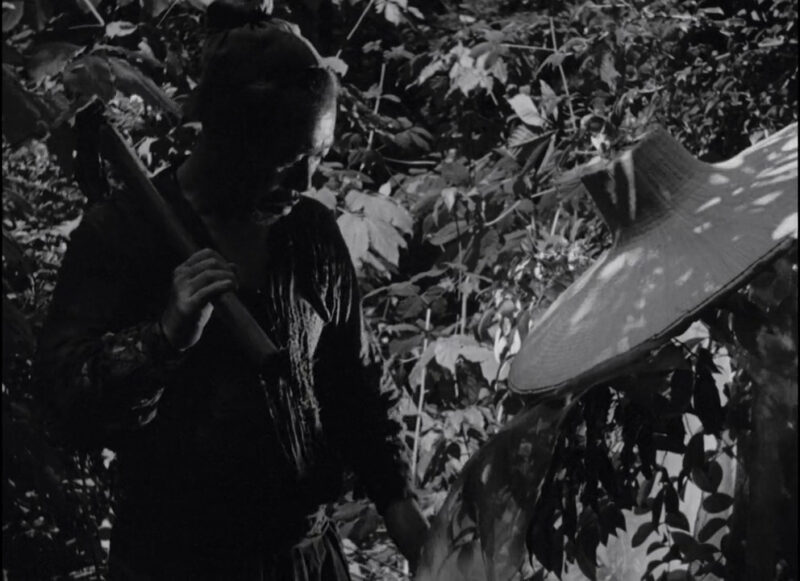
Why is Rashomon a historically significant film?
Rashomon has earned a special place in cinema history due to its unique narrative style, groundbreaking cinematic techniques, and profound exploration of complex themes. As a pioneer in employing a non-linear narrative structure and subjective storytelling, the film has had a transformative impact on cinematic storytelling, inspiring what is now often referred to as the “Rashomon effect.”
The “Rashomon effect” describes the phenomenon where different people have different interpretations or recollections of the same event. This concept has been explored in countless films and literary works after Rashomon, demonstrating its cultural influence. By presenting multiple contradictory accounts of a single event, the film forced viewers to grapple with the subjective nature of truth and the complexities of human perception and memory.
Moreover, the film introduced groundbreaking cinematic techniques such as the use of flashbacks that contradict each other and unique camera angles. It also employed deep focus, atmospheric lighting, and dynamic editing that enhanced the narrative’s emotional depth and psychological complexity.
Which of the four characters are we supposed to believe?
The genius of Rashomon lies in its narrative ambiguity. It presents four contradictory accounts of the same event without offering a definitive version of the truth. This is not just a storytelling device but a thematic exploration of the subjective nature of truth and the complexity of human nature.
The bandit, the wife, the samurai (through the medium), and the woodcutter all provide their own version of events. However, each account is influenced by their individual perceptions, emotions, and motivations. They are all unreliable to some extent, reflecting their personal biases, their desire to present themselves in a favorable light, or their struggle to cope with their guilt.
We, as viewers, are put in the position of the observers at the gate—left to sift through the testimonies and form our own interpretations. The film suggests that the truth might be subjective and multifaceted, a composite of different perspectives rather than an objective reality.
Now it’s your turn
Have more unanswered questions about Rashomon? Are there themes or motifs we missed? Is there more to explain about the ending? Please post your questions and thoughts in the comments section! We’ll do our best to address every one of them. If we like what you have to say, you could become part of our movie guide!

